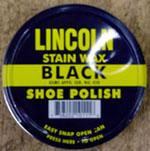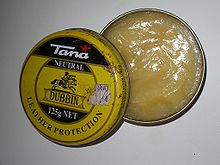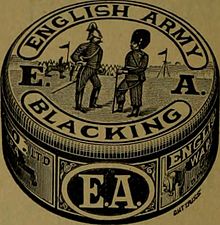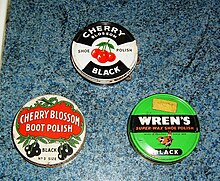Користувач:Anastasiyakurylo/Shoe polish
Поліроль - це воскова паста, крем або рідина, що використовується для полірування, надання блиску та водонепроникності шкіряному взуттю, для збільшення терміну служби взуття, а також для відновлення, підтримки та покращення зовнішнього вигляду.

Помилка цитування: Відкривальний тег <ref> неправильний або містить хибну назву.

Засоби для поліровки взуття можна розділити на три види: віск, крем-емульсія і рідина. Кожний відрізняється складі, але в основі всі містять суміш воску, розчинника та барвників.Помилка цитування: Відкривальний тег <ref> неправильний або містить хибну назву.
Цей тип поліролі складається з воску, органічні розчинників та фарби. Доля воску в складі - від 20 % до 40 %. Вміст представляє собою баланс між властивостями твердості і полірувальними особливостями після випаровування розчинника. Розчинники підбираються під тип воску. Засіб для поліровки на 70 % складається з розчинника. Використовуються різні розчинники, включаючи лігроїн. Скипидар, хоча і більш дорогий, має перевагу за рахунок свого "запаху взуття". Барвники складають остаточні 2-3% поліровки. Традиційний барвник - нігрозин, але інші фарбники (включаючи азобарвники) та пігменти використовуються для воскових, кордовських та коричневих лаків.
Нігросин - це поширений барвник у поліровці чорного кольору.
Завдяки високому вмісту летких розчинників, взуттєвий лак твердіє після нанесення, зберігши блиск. [2] Відомо, що погано змішані поліровки страждають від цвітіння, про що свідчить поява білого покриття стеарину на поверхні.

Помилка цитування: Відкривальний тег <ref> неправильний або містить хибну назву.Взуттєві креми використовуються в основному для живлення і відновлення шкіри. Ці креми мають в своєму складі невелику кількість воску, але це залежить від типу крему для взуття. Крем для взуття використовується для регулярного обслуговування взуття; в той час як лаки для взуття не потрібно застосовувати регулярно. [3]
Ці поліролі можуть мати желатинову консистенцію. Вони часто складаються з трьох компонентів - воску, розчинника та барвників. На відміну від взуттєвих восків, креми містять 50% води плюс 20-30% скипидару, тому вміст рідини високий. Емульгатори та поверхнево-активні речовини є необхідними. До них відносяться аміак, морфолін та різні етоксилідовані поверхнево-активні речовини, такі як полісорбат 80. Віск часто являє собою суміш карнаубський воску,бджолиного воску, монтанового воску та його окислених похідних та парафінових восків.
Рідкий взуттєвий матеріал продають у стиснутій пластиковій пляшці з невеликою губкою. Для зменшення в'язкості крему поліровані пляшки, як правило, мають дуже низький вміст воску. Рідкий крем для взуття являє собою складну суміш. Поліетиленова воскова емульсія є основним компонентом. Найрізноманітніші полімери, як правило, акрилати, є наступним основним компонентом, що забезпечує блиск і тримання барвників у суспензії. Смоли і казеїн застосовуються для забезпечення зчеплення зі шкірою. Також використовуються ефіри жирних фосфатів, емульгатори та гліколі. Пігменти включають діоксид титану для білих і оксид заліза для коричневих поліролей. Незважаючи на те, що рідкий крем дає швидкий блиск взуттю, багато експертів попереджають про його довгострокове використання, оскільки це може спричинити висихання шкіри та появленню тріщин.

Помилка цитування: Відкривальний тег <ref> неправильний або містить хибну назву.Процеси виготовлення деяких взуттєвих покриттів є простими, а необхідне обладнання порівняно легко придбати. Вартість створення виробничих потужностей для взуттєвої промисловості оцінюється в 600 000 доларів США (станом на 2005 рік). [6] [7]
Поліроль виготовляється у великих термостатованих перемішуючих реакторах. Вживаються кроки для забезпечення того, щоб леткі розчинники не випарувалися. Як правило, плавиться низькоплавкий парафіновий воск, потім вищий плавильний воск, і, нарешті, суміш барвник-стеарат. Перед розливанням до розплавленого розчину додають розплавлену масу. Взуттєве фарбування на основі воску традиційно упаковують у плоскі, круглі 60-грамові банки, як правило, з зручною кришкою. Традиційні плоскі, круглі банки з того часу стали синонімом поліролі. При висиханні, внаслідок втрати розчинника або з інших причин, затверділий віск відходить від стінок контейнера, даючи те, що називається «грейфер». [1]

From medieval times, dubbin, a waxy product, was used to soften and waterproof leather; but it did not impart shine. It was made from natural wax, oil, soda ash and tallow. As leather with a high natural veneer became popular in the 18th century, a high glossy finish became important, particularly on shoes and boots. In most cases, homemade polishes were used to provide this finish, often with lanolin or beeswax as a base.

In the late 18th and early 19th century many forms of shoe polish became available, yet were rarely referred to as shoe polish or boot polish. Instead, they were often called blacking, especially when mixed with lampblack, or still were referred to as dubbin. Tallow, an animal by-product, was used to manufacture a simple form of shoe polish at this time. Chicago, where 82% of the processed meat consumed in the United States was processed in the stock yards, became a major shoe polish producing area.[1]
In London the Warren brothers, Thomas and Jonathan, started making blacking around 1795–8, initially in partnership and then with competing companies. Jonathan Warren's Blacking company is noted as the first employer of the young Charles Dickens aged 12 in 1823.[2] The competitor to the Warren companies in London is the Day & Martin company formed in 1801.[3]
Details of the operation of Day & Martin in 1842 [4] reveal that the blacking they produced was in two forms, bottled liquid, and a thick paste which was available in either small wide-mouthed stone tubs, slabs wrapped in oiled paper, or in "circular tin-boxes, about three inches in diameter, and half or three-quarters of an inch thick". Tinned blacking paste was at this time exclusively for army use. The text states "Yet, as the soldier’s boots or shoes must to some extent emulate the brightness and glitter of the boots of those who pay for battles instead of fighting them, a portable blacking apparatus is provided." This confirms the tins as polish rather than dubbin.
In 1832, James S. Mason of Philadelphia began the commercial production of shoe blacking and inks. In 1851, James S. Mason & Co. constructed a building at 138/140 Front St. where ultimately ten million boxes were produced annually, to hold tins of blacking produced by two hundred employees. Later, tins of blacking were labeled as Mason Shoe Polish. This business ceased operation in 1919 and the building was razed in 1973.[5][6]
Other early leather preserving products included the Irish brand Punch, which was first made in 1851. In 1889, an English man by the name of William Edward Wren, started making shoe polishes and dubbin under the brand name Wren's. In just 3 years, he won the “First in the Field – First Award Leather Trades Exhibition 1892″ award which was awarded by the Leather Trades Exhibition held in Northampton, the centre of Britain’s boot making industry. This signified the importance and prestige of the exhibition in the trade and was a recognition of Wren's quality.[7] In 1890 the Kroner Brothers established EOS, a shoe polish factory in Berlin, which serviced the Prussian military. It finally closed in 1934 when the Nazis forbade Jews to operate a business.[8] The German brand, Erdal, went on sale in 1901.
Prior to 1906, shoe polish was not well known as a purchasable product, nor was it particularly sophisticated. While sales were not especially high, a few brands, like Nugget, were available in the U.K. during the 19th century. The practice of shining people’s shoes gradually caught on and soon many shoeshine boys in city streets were offering shoe shines using a basic form of shoe polish along with a polishing cloth.[9]

The first shoe polish to resemble the modern varieties (aimed primarily at inducing shine) were the British and British Commonwealth brands like Cherry Blossom, Kiwi, and Wren's. An advertisement published in March 1947 by Wren's claimed that William Wren originated the first wax polish in 1889. As the advertisement was endorsed with the Royal Warrant, its claim would be deemed creditable.[10] However, the most well known brand was Kiwi. Scottish expatriates William Ramsay and Hamilton McKellan began making "boot polish" in a small factory in 1904 in Melbourne, Australia.[11] Their formula was a major improvement on previous brands. It preserved shoe leather, made it shine, and restored color. By the time Kiwi Dark Tan was released in 1908, it incorporated agents that added suppleness and water resistance. Black and a range of colors became available, and exports to Britain, continental Europe, and New Zealand began, although the polish is now made in the Far East. Previously owned by the Sara Lee Corporation since 1984, Kiwi was sold in 2011 to SC Johnson[1].
Ramsay named the shoe polish after the kiwi, the national bird of New Zealand; Ramsay's wife, Annie Elizabeth Meek Ramsay, was a native of Oamaru, New Zealand.[12] It has been suggested that, at a time when several symbols were weakly associated with New Zealand, the eventual spread of Kiwi shoe polish around the world enhanced the Kiwi's popular appeal and promoted it at the expense of the others.[13]
A rival brand in the early years was Cobra Boot Polish, based in Sydney. Cobra was noted for a series of cartoon advertisements in The Sydney Bulletin, starting in 1909, using a character called "Chunder Loo of Akim Foo." Chunder is Australian slang for vomit, and possibly originated through the rhyming slang of Chunder Loo and spew (another slang word for vomit).[14]

At the end of the 19th century, leather shoes and boots became affordable to the masses, and with the outbreak of World War I in 1914, the demand for large numbers of polished army boots led to a need in the market for a product that would allow boots to be polished quickly, efficiently and easily. The polish was also used to shine leather belts, handgun holsters, and horse tack. This demand led to a rapid increase in the sales of shoe and boot polish. The popularity of Kiwi shoe polish spread throughout the British Commonwealth and the United States. Rival brands began to emerge, including Shinola and Cavalier (United States), Cherry Blossom (United Kingdom), Parwa (India), Jean Bart (France), and many others. Advertising became more prominent; many shoe polish brands used fictional figures or historical characters to spread awareness of their products. In the German documentary of 1927 Berlin: Symphony of a Metropolis, a scene focuses on shoe shining with a polish called Nigrin sporting the face of a black person.[15]

Вдосконалення виробництва взуття в середині 19-го століття дозволило заводи виробляють велику кількість взуття зі шкіри, а пізніше і синтетичних матеріалів. Це зростання у виробництві шкіри взуття триває в 20-му столітті і призвело до збільшення числа роздрібних магазинів взуття в промислово розвинених країнах, а потім заклик до взуття споживачами взуття.
Soldiers returning from the war continued to use the product, leading to a further surge in its popularity. While Kiwi shoe polish was what business historian Alfred D. Chandler, Jr. would call a "first mover", Kiwi did not open a manufacturing plant in the USA until after World War II.[16] Prior to this, Cavalier Shoe Polish, founded by James Lobell, had operated in the USA since 1913. The sales paradigm of Cavalier polish was to have footwear professionals sell Cavalier's high-end shoe polish to the shoe-buying public. A few years after World War II, Kiwi opened a manufacturing plant in Philadelphia, making only black, brown, and neutral shoe polish in tins.[17] Kiwi purchased Cavalier in 1961, and continued to manufacture products under the name until the year 2000.[18]
Shoe polish products are low-value items that are infrequently purchased, as a single can might last several months for even the most frequent user. Consumer demand is inelastic and largely insensitive to price change, while sales volumes are generally low. In the shoe polish market as a whole, some 26% of turnover is accounted for by pastes, 24% by creams, 23% by aerosols, and 13% by liquids.[19] In recent years, the demand for shoe polish products has either been static or declined; one reason is the gradual replacement of formal footwear with sneakers for everyday use.
There are numerous branded products available, as well as generic store brands. There are two chief areas of shoe polish sales: to the general public, and to specialists and trade, such as shoe repairers, and cobblers. The sales percentages between the two outlets are roughly comparable.[20]
Kiwi was acquired by the American company Sara Lee following its purchase of Reckitt and Colman in 1991 and Knomark with its brand Esquire Shoe Polish in 1987.[19][20] The Federal Trade Commission ruled that Sara Lee had to divest its ownership of these companies in 1994 to prevent it from becoming a monopoly. Since this ruling, Sara Lee has been prevented from acquiring any further assets or firms associated with chemical shoe care products in the United States without prior commission approval.[21] The Competition Commission in the United Kingdom investigated the potential monopoly of Sara Lee in the shoe care industry.[20][22] By the end of 2010, Sara Lee's Household & Body Care division (which included KIWI) was acquired by S.C.Johnson & Son.
Kiwi polish was also used heavily by the U.S. Military[23] and the Canadian Armed Forces.
Популярність гуталин паралельно загальному зростанню шкіри і виробництво синтетичної взуття, на початку 19 століття і триває до 20-ї. Світові війни спостерігався сплеск попиту на продукт.
-
Ківі гуталіном закаточної машини в 1972 - порожні банки завантаженням
-
Повні банки з машини
-
Персонал приганяє по руці
-
Персонал упаковка банок в коробки
-
1972, ківі гуталіном складського зберігання, К&М свічки і гуталинной фабрики, brockholes квитки на, Західний Йоркшир
Shoe polish is applied to the shoe using a rag, cloth, or brush. Shoe polish is not a cleaning product: it is suited for clean and dry shoes. A vigorous rubbing action to apply the polish evenly on the boot, followed by further buffing with a clean dry cloth or brush, usually provides good results. Another technique, known as spit-polishing or bull polishing, involves gently rubbing polish into the leather with a cloth and a drop of water or spit. This action achieves the mirror-like, high-gloss finish sometimes known as a spit shine or bull which is especially valued in military organizations. Despite the term, saliva is less commonly used as the vehicle or diluent with polish than is water. Polishes containing carnauba wax can be used as a protective coating to extend the life and look of a leather shoe.[24]
Shoe polish may be purchased pre-soaked into a hard sponge, which can be used to buff leather without needing to apply any additional polish to either the leather or the sponge. This is usually known as an applicator.
Many products are closely related to shoe polish, but not strictly considered as such. Other chemical products may be used to clean and shine shoes—in particular whiteners for white shoes, and a variety of sprays and aerosols for cleaning and waterproofing suede shoes.[19] A banana peel can also be used to effectively shine shoes,[25] but it is not recommended.
Although shoe polish is primarily intended for leather shoes, some brands specify that they may be used on non-porous materials, such as vinyl. The polish is generally the same colour as the shoes it will be used upon, or it may be neutral, lacking any intrinsic colour.
- ↑ History files, The Stockyards: Slaughterhouse to the world, Meatpacking technology. [Архівовано 2007-04-04 у Wayback Machine.] Chicago Historical Society. Accessed November 27, 2007.
- ↑ 'Charles Dickens and the Blacking Factory’ by Michael Allen. Published 2011
- ↑ "Day & Martin", Grace's Guide
- ↑ 'A Day at Day and Martins', The Penny Magazine, Dec 1842
- ↑ Philadelphia and Its Manufacturers: A Hand-book of the Great Manufactories and Representative Mercantile House of Philadelphia 1867, Edwin Troxwell Freedley, Edward Young & Co, Philadelphia, 1867
- ↑ Susina Plantation: the Masons. Accessed June 11, 2015
- ↑ Polish outfit tins. Blanco and Bull. Процитовано 6 грудня 2015.
- ↑ Adressbücher, Center for Berlin Studies, Berlin, 1890: Gebrüder Kroner, Chemische Fbrk., Zintern, Lade, chem. Präper. Fette, S. Annenstr. 14 Pt. Inh. Hugo u. Siegfried Kroner (Translation: Kroner Brothers, Chemical Factory, Polish, …chemical preparations, fat, South Annenstraße 14, parterre, owners Hugo and Siegfried Kroner. Addresses listed in the phone books include: 1890-92 EOS:Annenstraße 14, 1893- EOS:Hagelberger Straße 6 Parterre (ground floor),1902-09EOS: Alexandrinenstraße 119, 120, 1911-34 EOS: Warschauer Straße 31-36
- ↑ History of shoe shining. [Архівовано 2009-11-13 у Wayback Machine.] shoeshine-boy.com. Accessed November 28, 2007.
- ↑ Press advertisement: Wren's shoe polish | Details. www.hatads.org.uk. Процитовано 6 грудня 2015.
- ↑ William Ramsay. White Hat Tours (February 22, 2004). Internet archive version. Accessed November 11, 2007.
- ↑ Going High to Hauroki. [Архівовано 2005-12-27 у Wayback Machine.] Kiwiphile, Volume XIII, No. 1, September 2000. Accessed November 27, 2007.
- ↑ Imagination: 100 years of bright ideas in Australia [Архівовано 2011-07-20 у Wayback Machine.] (PDF). Australian Government, chapter 3 (iv) 2004-01-22, page 7. Accessed November 28, 2007.
- ↑ Dodd, Robert. Sez you. Take Our Word For It, Issue 173, page 4. Accessed November 27, 2007.
- ↑ Berlin: Symphony of a Great City (full video). Internet Archive. 1927. Процитовано 11 June 2018.
- ↑ DeMeilo, Margot (2009). Feet and Footwear: A Cultural Encyclopedia (вид. Illustrated). ABC-CLIO. с. 282. ISBN 9780313357152.
- ↑ Kiwi Polishes Up Its Line Of Products. Orlando Sentinel. 11 March 1990. Процитовано 11 June 2018.
- ↑ Steven Anthony Hill Collection Guide. East Carolina University. Процитовано 11 June 2018.
- ↑ а б в Conclusions [Архівовано 2005-03-02 у Wayback Machine.] (PDF). UK Competition Commission (1992) - Conclusions of a report on Sara Lee and the shoe polish market in general. Accessed November 26, 2007.
- ↑ а б в Sara Lee Corporation and Reckitt & Colman plc: A report on the acquisition by the Sara Lee Corporation of part of the shoe care business of Reckitt & Colman plc. [Архівовано 2005-12-17 у Wayback Machine.] UK Competition Commission (1992). Accessed on November 27, 2007.
- ↑ Sara Lee's potential monopoly (annual report) (PDF). Federal Trade Commission (1994). Accessed November 27, 2007.
- ↑ Sara Lee Will Pay Record $3.1 Million Civil Penalty for Violating Antitrust Premerger Notification Requirements (Пресреліз). US Department of Justice. 6 лютого 1996. Архів оригіналу за 8 лютого 2008.
{{cite press release}}: Cite має пустий невідомий параметр:|df=(довідка) - ↑ The simple way of polishing boots. Instructables.com. Процитовано 28 жовтня 2015.
- ↑ Morris, Theodore. "Protective Coating Compositions". United States Patent 3700013, FreePatentsOnline.com. Accessed February 05, 2008.
- ↑ Extraordinary Uses for Ordinary Things. Reader's Digest. 2004. с. 77. ISBN 0-7621-0705-7.
[[Категорія:Засоби для чищення]]





